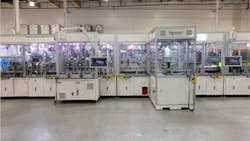Intelligent Conveyors Transform Medical Device Manufacturing
From wearable monitors to smart drug delivery systems, the demand for medical devices has surged as healthcare systems increasingly rely on innovative technologies to improve patient care. In response, manufacturers are scaling production to meet these growing needs while maintaining precision and regulatory compliance.
Deloitte research shows that nearly 60% of life sciences manufacturing executives are prioritizing the optimization of their operating models in 2025, and close to 30% are focusing on performance improvement initiatives, such as cost-cutting, to enhance efficiencies and increase returns.
However, scaling production to meet demands isn't as simple as adding more machines or expanding factory floors. Production takes place in cleanroom environments, where space is limited, making expansion costly. In addition, every step in the process — from assembling components to final testing — must be FDA-validated, ensuring precision and compliance with strict regulations.
The limitations of a traditional belt-driven conveyor approach
For one medical device manufacturer, the transition from manual assembly to automated production was a complex yet necessary step toward scaling up efficiently. The manufacturer needed help modernizing its production line and turned to Automation NTH, a provider of turnkey custom automation equipment that specializes in high-precision, discrete manufacturing. Known for its expertise in life sciences and other complex industries, Automation NTH was tasked with increasing the manufacturer’s capacity while reducing the cost per unit —all without altering their validated assembly process or expanding their cleanroom footprint.
The manufacturer’s assembly process involved approximately 30 intricate steps, such as fine wire bending, soldering, epoxy dispensing and curing. Each step required extreme precision, making automation a complex undertaking.
Initially, Automation NTH implemented a validated, modular assembly system based on traditional belt-driven conveyors. While this approach was effective, the system had limitations in speed and flexibility, posing challenges as the manufacturer continued to scale up.
The advantages of an intelligent conveyor system
Recognizing the constraints of traditional conveyor technology, Automation NTH turned to Rockwell Automation’s MagneMover Lite, an intelligent conveyor system designed for high-speed, high-precision applications.
Unlike conventional belt-driven systems, MagneMover Lite uses magnetically propelled carriers that move independently, meaning parts could be routed dynamically through the assembly line based on real-time production needs. This allows for greater efficiency and a significantly smaller footprint.
To integrate this technology, Automation NTH developed a proprietary software engine that serves as an interface between the MagneMover Lite carriers and the controller. This software allows for precise control of acceleration, velocity and station assignments to ensure maximum efficiency at every stage of production.
The system was also designed with flexibility in mind. Though the medical device is now fully machine-assembled, the manufacturer wanted the option to incorporate robotic and manual pick-and-load processes based on business needs. Automation NTH engineered the system to support both approaches, ensuring adaptability for future production requirements.
Double digit reductions in cost per part and application footprint
The impact of the MagneMover Lite integration was immediate and substantial. The manufacturer was able to double production speed and capacity within the same floor space, resulting in a 40% decrease in cost per part. And by replacing the belt-driven conveyor system, the intelligent conveyor’s compact design also reduced the application’s footprint by 38%.
These results allowed the manufacturer to achieve its key objective of scaling production while reducing the cost per part to make the product more accessible to patients worldwide.
Mike Baranski is global life science technology consultant at Rockwell Automation.
More conveyor coverage from Automation World:
About the Author

Leaders relevant to this article:
